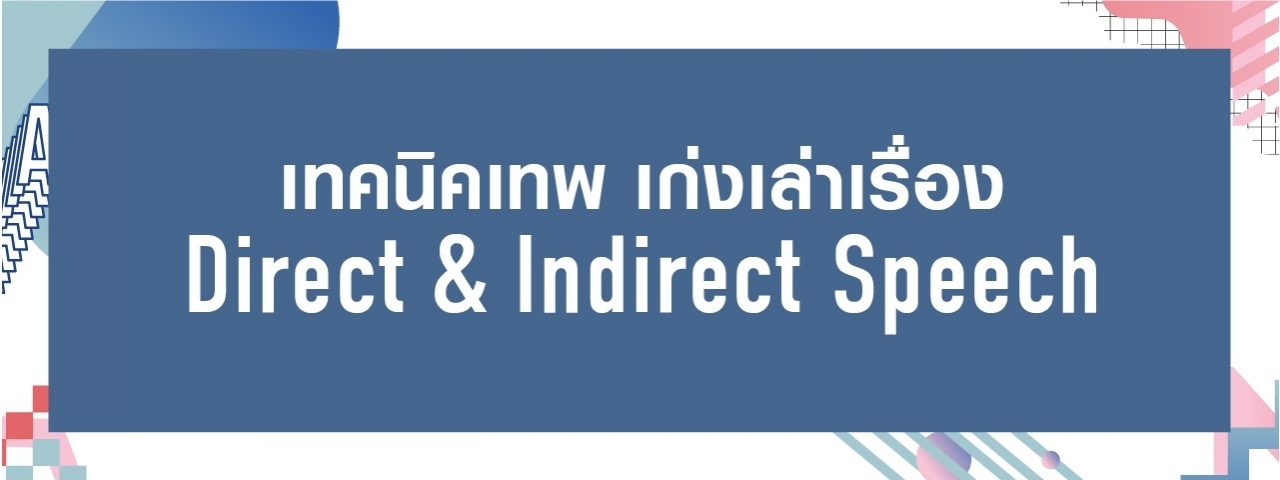

 362,735 Views
362,735 ViewsDirect Speech คือ การนำคำพูดของผู้อื่นมาพูดแบบตรง ๆ โดยไม่มีการเปลี่ยนแปลงโครงสร้างหรือเติมคำพูดใด ๆ เข้าไป และคำพูดนั้นจะอยู่ในเครื่องหมายคำพูด (Quotation Mark “…”) เช่น
Tom said, “I have dinner with my wife.”
หรือ “I have dinner with my wife.”, Tom said.
ทอมพูดว่า “ผมทานมื้อเย็นกับภรรยาของผม”
She said, “I’m teaching English online.”
หรือ “I’m teaching English online,” she said.
เธอพูดว่า “ฉันกำลังสอนภาษาอังกฤษออนไลน์”
1. หลังประโยคหลักจะต้องคั่นด้วยเครื่องหมาย comma (,) เสมอ เช่น She said, “I’m teaching English online.”
2. หากสลับเอาประโยคในเครื่องหมายคำพูดขึ้นก่อน เมื่อจบประโยคให้ใส่เครื่องหมาย comma แล้วปิดด้วยเครื่องหมายคำพูด จึงตามด้วยชื่อผู้พูด เช่น “I’m teaching English online,” she said.
3. ประโยคในเครื่องหมายคำพูดจะขึ้นต้นด้วยตัวพิมพ์ใหญ่
Indirect Speech หรือ Reported Speech คือ การนำคำพูดของผู้อื่นมาดัดแปลงเป็นคำพูดของผู้พูดเอง แล้วเล่าให้ผู้อื่นฟัง ซึ่งจะมีการเปลี่ยนแปลงโครงสร้างประโยคเดิม และไม่มีการใส่เครื่องหมายคำพูด เช่น
Direct Speech: Tom said, “I have dinner with my wife.” (ทอมพูดว่า “ผมทานมื้อเย็นกับภรรยาของผม”)
Indirect Speech: Tom said (that) he had dinner with his wife. (ทอมพูดว่าเขาทานมื้อเย็นกับภรรยาของเขา)
Direct Speech: She said, “I’m teaching English online.” (เธอพูดว่า “ฉันกำลังสอนภาษาอังกฤษออนไลน์”)
Indirect Speech: She said (that) she was teaching English online. (เธอพูดว่าเธอกำลังสอนภาษาอังกฤษออนไลน์)
1. เปลี่ยน Tense
|
Direct Speech |
Indirect Speech |
|
Present simple |
Past simple |
|
Present continuous |
Past continuous |
|
Present perfect simple |
Past perfect simple |
|
Present perfect continuous |
Past perfect continuous |
|
Past simple |
Past perfect |
|
Past continuous |
Past perfect continuous |
|
Past perfect |
Past perfect |
|
Past perfect continuous |
Past perfect continuous |
เปลี่ยน Modal Verbs (กริยาช่วย)
|
Direct Speech |
Indirect Speech |
|
will / shall |
would / should |
|
can |
could |
|
may |
might |
|
must |
had to |
ข้อควรจำ: Direct Speech ที่ใช้ Modal Verbs – could, would, should, might และ ought to อยู่แล้ว เมื่อทำเป็น Indirect Speech ไม่ต้องเปลี่ยนคำกริยาช่วยเหล่านี้
2. เปลี่ยนคำกริยาของประโยคนำ (Reporting Verb)
|
Direct Speech |
Indirect Speech |
|
says |
says (that) |
|
said |
said (that) |
|
say to + บุคคล |
tell + บุคคล + (that) |
|
said to + บุคคล |
told + บุคคล + (that) |
3. เปลี่ยนสรรพนามบุคคล (Personal Pronoun)
|
Direct Speech |
Indirect Speech |
|
I |
he/she |
|
me |
him/her |
|
my |
his/her |
|
mine |
his/hers |
|
myself |
himself/herself |
|
we |
they |
|
us |
them |
|
our |
their |
|
ours |
theirs |
|
ourselves |
themselves |
|
you (ประธาน) |
he/she |
|
you (กรรม) |
me |
|
your |
my |
|
yours |
mine |
|
yourself |
myself |
|
yourselves |
ourselves |
4. เปลี่ยนคำแสดงระยะใกล้เป็นไกล (Nearness → Remoteness)
|
Direct Speech |
Indirect Speech |
|
here |
there |
|
this |
that |
|
these |
those |
และเปลี่ยนคำบอกเวลา (Adverbs of time)
|
Direct Speech |
Indirect Speech |
|
today |
that day |
|
yesterday |
the day before |
|
tomorrow |
the next day |
|
last night/week/month/year |
the night/week/month/year before |
|
next night/week/month/year |
the following night/week/month/year |
|
ago |
before |
|
a year/month ago |
a year/month before |
|
now |
then |
|
come |
go |
1. Indirect Speech – Statement คือ รูปประโยคบอกเล่าหรือประโยคปฏิเสธ มีหลักการเปลี่ยนดังนี้
1.1. ตัดเครื่องหมาย comma (,) และเครื่องหมายคำพูด (“…..”) ออก
1.2. เปลี่ยน Reporting Verb ตามความเหมาะสม (ดูหลักการเปลี่ยน Reporting Verb จากตารางด้านบน) และจะเติม that หลัง Reporting Verbs หรือไม่ก็ได้
1.3. เปลี่ยนสรรพนามให้เหมาะสม (ดูหลักการเปลี่ยนสรรพนามจากตารางด้านบน)
1.4. เปลี่ยนคำแสดงระยะใกล้เป็นไกล และคำระบุเวลา
1.5. เปลี่ยน Tense ให้เหมาะกับ Reporting Verb ดังนี้
ถ้า Reporting Verb ใน Direct Statement อยู่ในรูป Present Tense ไม่ต้องเปลี่ยน Tense ใน Indirect Statement แต่ต้องเปลี่ยนรูปกริยาตามประธานในประโยค เช่น
Direct: She says, “I am happy.”
Indirect: She says (that) she is happy.
Direct: He says, “I love you.”
Indirect: He says (that) he loves me.
- ถ้า Reporting Verb ใน Direct Statement อยู่ในรูป Past tense ต้องเปลี่ยน Tense ใน Indirect Statement (ดูกฎการเปลี่ยน Tense ได้ตามตารางด้านบน) เช่น
เปลี่ยนจาก Present simple tense เป็น Past simple tense
Direct: She said, “I drink milk.”
Indirect: She said (that) she drank milk.
เปลี่ยน will เป็น would
Direct: He said, “I will meet her here tomorrow.”
Indirect: He said (that) he would meet here there the next day.
2. Indirect Speech – Commands, Requests, Suggestions คือ รูปประโยคคำสั่ง ขอร้อง หรือขออนุญาต มีหลักการเปลี่ยนดังนี้
2.1. ใช้กริยานำ (Reporting Verb) ให้เหมาะสม เช่น tell/told (บอก), ask/asked (ขอร้อง), request/requested (ขอร้อง), beg/begged (วิงวอน), advise/advised (แนะนำ), propose/proposed (เสนอแนะ), command/commanded (สั่ง), order/ordered (สั่ง), forbid/forbade (สั่งห้าม), warn/warned (เตือน)
2.2. ใช้ to+V.1 ในการ บอก, แนะนำ, ขอร้อง หรือสั่งให้ทำ ถ้าเป็นปฏิเสธหรือห้ามทำ ใช้ not to + V.1
2.3. ถ้าประโยค Direct Speech ไม่มีกรรม ให้เติมกรรมในประโยค Indirect Speech
2.4. ถ้าในประโยค Direct Speech มีคำว่า please ให้ตัดออก
ตัวอย่าง:
Direct : The teacher said, “come in.”
Indirect: The teacher told him to come in.
Direct : Tom begged, “Please move into the living room.”
Indirect: Tom begged me to move into the living room.
Direct: The doctor said, “Don’t smoke.”
Indirect: The doctor advised me not to smoke.
3. Indirect Speech – Question คือ รูปประโยคคำถาม มีหลักการเปลี่ยนดังนี้
3.1. ตัดเครื่องหมายคำถาม (?) ออก เพื่อให้อยู่ในรูปประโยคบอกเล่า
3.2. เปลี่ยนกริยานำ (Reporting Verb) จาก say, said, told เป็น ask/asked (ถาม), inquire/inquired of (สอบถาม)
3.3. ประโยคคำถามที่ขึ้นต้นด้วย Verb to do, to have, to be, และกริยาช่วย (Auxiliary verbs) Will, Can, etc. เป็นต้น จะต้องเชื่อมประโยคด้วย if, whether, whether or not, whether….or not to
3.4. ประโยคคำถามที่ขึ้นด้วย Wh-Questions: What, Where, When, Why, Who, Whom, Whose และ How ใช้คำเหล่านี้เป็นตัวเชื่อมประโยคได้เลย
ตัวอย่าง:
Direct: Sompong said to us, “Are you leaving for Bangkok today?”
Indirect: Sompong inquired of us whether we were leaving for Bangkok that day.
Direct: She said to me, “Can you sing a song?”
Indirect: She asked me if I could sing a song.
Direct: He said to her, “What are you doing now?”
Indirect: He asked her what she was doing then.
